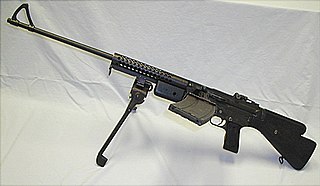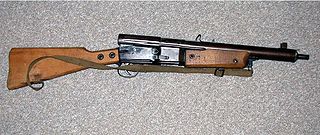
The StG 44 is a German assault rifle developed during World War II by Hugo Schmeisser. It is also known by its early designations as the MP 43 and MP 44. The StG 44 was an improvement of an earlier design, the Maschinenkarabiner 42(H).

The FG 42 is a selective-fire 7.92×57mm Mauser automatic rifle produced in Nazi Germany during World War II. The weapon was developed specifically for the use of the Fallschirmjäger airborne infantry in 1942 and was used in very limited numbers until the end of the war.

The Gewehr 43 or Karabiner 43 is a 7.92×57mm Mauser caliber semi-automatic rifle developed by Germany during World War II. The design was based on that of the earlier G41(W) but incorporated an improved short-stroke piston gas system similar to that of the Soviet SVT-40.

An automatic rifle is a type of autoloading rifle that is capable of fully automatic fire. Automatic rifles are generally select-fire weapons capable of firing in semi-automatic and automatic firing modes. Automatic rifles are distinguished from semi-automatic rifles in their ability to fire more than one shot in succession once the trigger is pulled. Most automatic rifles are further subcategorized as battle rifles or assault rifles.

A battle rifle is a semi-automatic or select fire service rifle chambered to fire a full-power cartridge and a internal box magazine or detachable box magazine. The term "battle rifle" is a retronym created largely out of a need to better differentiate the intermediate-power cartridge assault rifles from full-powered rifles as both classes of modern firearms have a similar appearance and share many of the same features such as detachable magazines, pistol grips, or separate upper and lower receivers. Battle rifles were most prominent from the 1940s to the 1970s, when they were used as service rifles. While modern battle rifles largely resemble modern assault rifle designs, which replaced battle rifles in most roles, the term may also describe older military full-power semi-automatic rifles such as the M1 Garand, SVT-40, Gewehr 41, Gewehr 43, Type 4, FN Model 1949, and MAS-49.

The M1941 Johnson Light Machine Gun, also known as the Johnson and the Johnny gun, was an American recoil-operated light machine gun designed in the late 1930s by Melvin Johnson. It shared the same operating principle and many parts with the M1941 Johnson rifle and the M1947 Johnson auto carbine.
The Sturmgewehr 57 is a selective fire battle rifle designed by Schweizerische Industrie Gesellschaft of Switzerland. The Stgw. 57 assault rifle uses a roller-delayed blowback system similar to the blowback system of the Heckler & Koch G3 and CETME rifles. As an assault rifle, the model AM 55 entered service in the Swiss Army in three designations F. ass. 57 7.5mm and 7.5mm Stgw. 57. Technologically, the Stgw. 57 was the mechanical and design basis for the export-variations of the SG 510 family of small arms. After thirty-three years, from 1957 to 1990, the Swiss Army replaced the Stgw. 57 with the SIG SG 550, a lighter-weight assault rifle.

A service rifle or standard-issue rifle is a rifle a military issues to its personnel, typically to its regular infantry. In modern militaries, this is generally a versatile and rugged assault rifle or battle rifle, suitable for use in nearly all environments and effective in most combat situations. Almost all modern militaries are issued service pistols as sidearms to accompany their service rifles. The term can also be used to describe weapons issued by non-military forces, such as law enforcement or paramilitaries.

The 7.5×55mm Swiss or 7,5mm GP 11 is a cartridge developed for the Swiss Army. It originated from the Gewehrpatrone 1890 (7.5×53.5mm) developed in 1898 by mechanical engineer Lt. Col. Eduard Rubin for rifles based on Rudolf Schmidt's action design. The 7.5×55mm Swiss GP 11 cartridge is similar in appearance to the slightly smaller 7.5×54mm French round though the two are not interchangeable.

The ZG 1229 Vampir 1229, also known by its code name Vampir, was an active infrared device developed for the Wehrmacht for the Sturmgewehr 44 assault rifle during World War II, intended primarily for night use. Designed by C.G. Haenel, the Vampir was used in small numbers in the Eastern Front.

The Volkssturmgewehr is the name of several rifle designs developed by Nazi Germany during the last months of World War II. They share the common characteristic of being greatly simplified as an attempt to cope with severe lack of resources and industrial capacity in Germany during the final period of the war. The Volkspistole was a partner program, almost identical, but for pistols instead.

An intermediate cartridge is a rifle/carbine cartridge that has significantly greater power than a pistol cartridge but still has a reduced muzzle energy compared to fully powered cartridges, and therefore is regarded as being "intermediate" between traditional rifle and handgun cartridges.
The StG 45(M) (abbreviation of Sturmgewehr 45, "Assault Rifle 45") sometimes referred to as the MP 45(M), was a prototype assault rifle developed by Mauser for the Wehrmacht at the end of World War II, using an innovative roller-delayed blowback operating system. It fired the 7.92×33mm Kurz (or "Pistolenpatrone 7.9mm") intermediate cartridge at a cyclic rate of around 450 rounds per minute.
The evolution of German military rifles is a history of common and diverse paths followed by the separate German states, until the mid-19th century when Prussia emerged as the dominant state within Germany and the nation was unified. This article discusses rifled shoulder arms developed in or for the military of the states that later became Germany; it excludes firearms of the Austrian Empire, except where they were used substantially by German troops.

Waffenfabrik Bern, also known as W+F Bern, was an arms manufacturer in Bern, Switzerland, which was a government-owned corporation producing firearms for the Swiss Armed Forces.

An assault rifle is a select fire rifle that uses an intermediate-rifle cartridge and a detachable magazine. Assault rifles were first put into mass production and accepted into widespread service during World War II. The first assault rifle to see major usage was the German StG 44, a development of the earlier Mkb 42. While immediately after World War II, NATO countries were equipped with battle rifles, the development of the M16 rifle during the Vietnam War prompted the adoption of assault rifles by the rest of NATO. By the end of the 20th century, assault rifles had become the standard weapon in most of the world's armies, replacing full-powered rifles and submachine guns in most roles. The two most successful modern assault rifles are the AK-47 and the M16 designs and their derivatives.

The 7.92×33mm Kurz is a rimless bottlenecked intermediate rifle cartridge developed in Nazi Germany prior to and during World War II, specifically intended for development of the Sturmgewehr 44. The ammunition is also referred to as 7.9mm Kurz, 7.9 Kurz, 7.9mmK, or 8×33 Polte. The round was developed as a compromise between the longer 7.92×57mm full-power rifle cartridge and the 9×19mm Parabellum pistol cartridge, and is the first mass-used intermediate cartridge in the world.
The Vollmer M 35 consisted of a series of experimental automatic rifles developed by Heinrich Vollmer in the 1930s. The Vollmer rifles were chambered in an intermediate cartridge that was co-developed with Gustav Genschow and Co. (GECO) starting in 1934, under a Heereswaffenamt contract.

The Maschinenkarabiner 42(H) or MKb 42(H) (machine carbine Model 1942 (Haenel)) was an early German assault rifle firing an intermediate round of World War II. Designed in 1940 – 1941 by Hugo Schmeisser working for C. G. Haenel Waffen und Fahrradfabrik, several thousand were made and the gun was used on the Eastern Front in 1943.

The Maschinenkarabiner 42(W) (German: "machine carbine model 1942 (Walther)" ) or MKb 42(W) was an early German assault rifle designed in 1940-41 by Walther during World War II. The Mkb 42(W), and the more successful Maschinenkarabiner 42(H) designed by Haenel, were predecessors of the Sturmgewehr 44 (StG 44) assault rifle.















